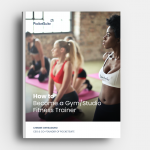Zumba is an exciting dance fitness program created in 1998 by Colombian dancer and choreographer Alberto “Beto” Pérez. Since then Zumba has become an international phenomenon, with courses taught in more than 180 countries.
Zumba is a total-body cardio and aerobic workout, which burns calories like they’re on fire. One study showed that a typical Zumba student burns 300 to 900 calories an hour with Zumba.
Zumba choreography is composed using all or some of the sixteen core steps. There are four basic rhythms: salsa, reggaeton, merengue and cumbia. Each rhythm has four main steps.
The Zumba Fitness program is a trademarked, Latin-inspired cardio-dance workout that uses music and choreographed steps to create a party atmosphere. Although the program launched with Latin music as the primary influence, classes today feature a background of African beats, pop music, hip-hop, jazz and country. Here’s what you’ll learn in this article:
- How Much You Can Make
- Training and Certification
- Costs
- Career Options
- Finding Clients
- Helpful Tips for Zumba Instructors
On their website, Zumba Fitness notes that people of all ages can safely participate and enjoy this form of dance exercise. This is because the Zumba method alternates high-intensity dance moves with low-intensity steps. The intervals between these changes help students maintain a calorie-burning pace without wearing themselves out before the class is over. Many classes throughout the world are designed for older people to help them improve motion, strength and posture, and to get out and socialize in a fun atmosphere.
Zumba can also help reduce the risk of heart disease and lower blood pressure while decreasing your bad cholesterol and boosting good cholesterol levels.
Because Zumba is a trademarked fitness program, you’ll need to become a certified instructor to teach the program and to use Zumba promotional materials for your gym or studio.
Read on to learn how you can teach classes that Zumba students describe as “joyful” “a party” and “a vibe with a sense of empowerment.”
How Much You Can Make?
Nationally, the average base pay for a Zumba instructor is currently $29 an hour.

ZipRecruiter reports a salary range of $22,500 to $105,000 annually, depending on your experience and location.
For a comparison, here’s a state by state guide to personal trainer salaries.
You can make even more at special events. Instructors at Zumba parties often earn $100 to $150 an hour.
According to a CNN Money article titled Best Jobs in America, personal training ranked at number 18, with an average salary of $56,000. That’s right in line with a full-time Zumba instructor’s pay, The top trainers in the country reported an average annual salary of $128,000. The profession has experienced a 24 percent growth rate over the past decade, and continued job growth is expected. That includes Zumba instruction.
Training and Certification
The first step on your way to Zumba certification is to click here to find a licensed instructor and training schedule in your area.
Zumba Basic 1 is the first course in your training. In this class you’ll learn:
- How to teach the basic steps to the four Zumba core rhythms: Merengue, Salsa, Cumbia, and Reggaeton.
- Use the Zumba formula to identify different parts of a song and apply the basic steps to build an effective Zumba class.
- Practice live with a Zumba Education Specialist. This is designed to help you build confidence so you can teach sooner.
Check out this video to get a feel for what a Zumba class is like.
Costs
The cost of the Basic 1 course varies by locality, ranging from about $225 to $350. A lower price is available for early registration, then the cost increases by as much as 30 percent a few weeks before the scheduled class. To save money, you’ll want to register at least a month in advance.
Upon completion you will receive your license to begin teaching Zumba classes immediately.
Licensed instructors receive access to additional Zumba learning tools as well as new choreographies every month, music for your classes and ongoing support.

From there, you can pursue advanced training with Jump Start Gold or Jump Start Kids & Kids Jr..
There are no prerequisites to be a Zumba Instructor, although a fitness or dance background is a plus. You must be at least 18 years old to enroll in Zumba Instructor Training.
Successful completion of Basic 1 Training comes with a license to teach Zumba valid for six months. If you become a ZIN member your teaching license will not expire for as long as you maintain membership.
To teach children, you’ll need to complete the Jump Start Kids course. This class covers all the information you need to know to teach kids at two levels, ages 4-6 and 7-11.
The class includes a review of the Basic 1 course.
When you sign up for the ZIN program, you commit to a 6-month membership. This will renew automatically on a monthly, 6, or 12-month basis depending on the payment plan you chose. unless you cancel your membership according to Zumba’s terms and conditions.
Professional certification is also a typical pursuit among personal trainers, and many employers now require some type of nationally accredited certification.
Benefits of ZIN membership:
- License to teach indefinitely. As a ZIN Member, your license does not expire.
- Monthly access to new music and choreography routines. This helps keep classes fresh and exciting.
- Marketing Tools. Personalized marketing materials and an online instructor page to promote your classes.
- Community Support. ZIN membership lets you connect and network with other Zumba instructors around the world.
Professional Groups to Join
You don’t have to join other fitness trainer organizations to be a Zumba instructor. But extra credentials can give you an advantage in the market.
If you’re not ready or able to open your own Zumba studio, your initial point of entry – will be to work for someone who does have a facility. If you have accreditation from one of these organizations to go with your Zumba certification, that may be a differentiator for future employers:
The National Academy of Sports Medicine is seen as one of the best organizations for personal trainer certification. NASM membership costs between $524 and $2,400 depending on the type of certification.
The National Council for Certified Professional Trainers is nationally accredited by the NCCA. The cost of NCCPT certification ranges between $250 and $550.
Both of these organizations require recertification every two years with proof of 20 hours of continuing education.
You can join The National Strength and Conditioning Association for a $120 fee. Accredited members receive professional designation, access to fitness articles and research, trainer best practices, business tips and networking with other members.
For social networking, there are many Zumba groups to join on Facebook. Check out a starter list of Facebook groups here.
Career Options
With Basic 1 certification and a ZIN membership, you’re qualified to teach Zumba adult courses. Because these dance exercise classes are so popular you’ll find job openings throughout the United States and the world. There are more than 200,000 dedicated Zumba dance studios in 180 countries worldwide as well as gyms and private studios that offer (or want to offer) Zumba classes as part of their fitness training service list.
You’re more likely to find full-time employment with a Zumba studio while part-time jobs are available for teaching weekly classes at a gym. This is where it becomes useful to hold a Jump Start Kids teaching certification – you’ll be able to offer classes to a wider age group and get more bookings.
Finding Clients
- According to Zumba, word-of-mouth marketing is the main reason Zumba spread to over 180 countries. Ask your clients to tell their friends. Ask your friends to tell their friends about your Zumba classes.
- Use the support Zumba provides.
- Offer incentives to new and existing students. This can be a discount, a special deal for buying multiple classes or whatever incentive works for you. It can grow into a thriving referral program.
- Promote your Zumba studio across all social media platforms with links to your business website. Don’t forget to add an online booking link to your website and all of your social media profiles to make it easy for prospective clients to see your class times and self-book.
- Ask clients to offer a great review of your Zumba business on sites like Yelp.com.
Helpful Tips for Zumba Instructors:
- Not all instructors master the choreography of the four basic rhythms right away. Don’t be discouraged.
- Every class should begin with a warm-up and a cool down
- Early on, some of the dance moves might be hard on your knees
- Worldwide Zumba support is available. Click here for a complete list of Zumba offices by country.
If you enjoyed this article, check out some other PocketSuite.io content that can help you grow your business as a Zumba instructor. Here’s a great place to start.
PocketSuite has thousands of business owners who all started where you are right now. Our community is always happy to help you ramp up, grow your client base, and achieve your income goals, both within the PocketSuite app and as part of our exclusive Facebook Community Group. PocketSuite’s vision is for anyone to be able to work for themself and make a great living. It starts here. It starts with you. It starts today. Let’s get started, you can download PocketSuite for FREE here! Remember to reach out to us with any questions (we’d love to hear from you)! Text us @ (415) 841-2300.





